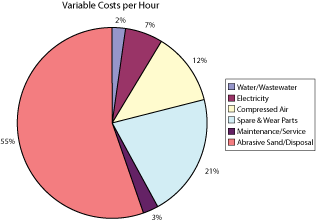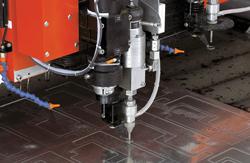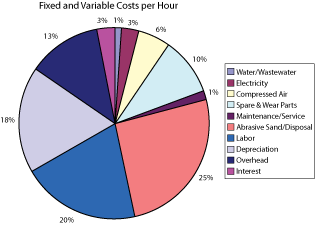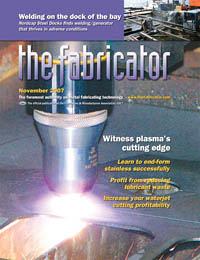- FMA
- The Fabricator
- FABTECH
- Canadian Metalworking
Categories
- Additive Manufacturing
- Aluminum Welding
- Arc Welding
- Assembly and Joining
- Automation and Robotics
- Bending and Forming
- Consumables
- Cutting and Weld Prep
- Electric Vehicles
- En Español
- Finishing
- Hydroforming
- Laser Cutting
- Laser Welding
- Machining
- Manufacturing Software
- Materials Handling
- Metals/Materials
- Oxyfuel Cutting
- Plasma Cutting
- Power Tools
- Punching and Other Holemaking
- Roll Forming
- Safety
- Sawing
- Shearing
- Shop Management
- Testing and Measuring
- Tube and Pipe Fabrication
- Tube and Pipe Production
- Waterjet Cutting
Industry Directory
Webcasts
Podcasts
FAB 40
Advertise
Subscribe
Account Login
Search
Increasing waterjet cutting profitability
How to get abrasive use and fixed costs under control
- By Jeff Day
- November 6, 2007
- Article
- Waterjet Cutting
Over the past five years, the number of waterjet cutting machines sold worldwide, both abrasive and pure water, has increased by an average of 18 percent annually. That growth is projected to continue for the foreseeable future. Fabricators are showing more interest in the technology as they realize it can cut metals of various thicknesses and different materials, while offering very high tolerances (seeFigure 1). As more waterjets are purchased, veteran and new waterjet owners must look for ways to increase profitability and remain competitive.
Figure 2shows the breakdown of the typical variable costs per hour for an abrasive waterjet. Here, abrasive is the largest portion of the cost by far. However, when you factor in fixed costs and labor costs, the pie changes dramatically (see Figure 3).
Abrasive remains the most significant expense, and anything you can do to reduce abrasive consumption will have a great effect on your cost per part. However, you also need to consider the other major factors of labor and fixed costs, such as depreciation, interest, and overhead.
Reducing Abrasive Consumption
Reducing abrasive consumption decreases direct part cost. It also decreases the amount of work required to empty the abrasive out of the machine's tank and the cost of disposal.
Smaller Nozzles. Using a smaller water/abrasive nozzle combination can reduce abrasive consumption dramatically. Fabricators generally cut with a 0.014-in. water nozzle and a 0.040-in. or 0.043-in. abrasive nozzle, using 1.2 to 2 pounds of abrasive per minute. Switching to a 0.010-in. water nozzle and 0.030-in. abrasive nozzle can reduce abrasive consumption to 0.75 to 0.9 lbs. per minute.
Most fabricators hesitate to change because a smaller water/abrasive nozzle combination results in fewer parts per hour. While this is true for cutting with a single head, two-head cutting with the smaller nozzle combination produces more parts per day at a lower abrasive cost per part. Not all parts are suitable for two-head cutting because of part size, but with a 5- by 10-ft. or larger table, most waterjet users find that the second head can be used most of the time.
If you cut with the 0.014-in./0.040-in. combination with one head at 20 inches per minute (IPM) and 2 lbs. per minute of abrasive, the 0.010-in./0.030-in. one-head setup would allow you to cut at 12 IPM and 1 lb./min. of abrasive for similar quality. The cut speed is reduced by 40 percent, and the abrasive is reduced by 50 percent.
When using two heads, effective cut speed is doubled to 24 IPM, and abrasive use is 2 lbs./min. Assuming abrasive costs $0.25/lb., the smaller nozzle combination results in an abrasive cost of $0.021/in. [(1 lb./min., 12 IPM) = 0.083 lb./in .x $0.25/lb. = $0.021/in.]. The larger nozzle combination costs $0.025/in. [(2 lbs./min., 20 IPM) = 0.1 lb./in. x $0.25/lb. = $0.025/in.]. So the small-nozzle combination is a 16 percent savings per inch of cutting. Considering the number of inches you will cut in a year, these fractions of a penny add up dramatically.
Pump Sizing for Two-head Cutting. If you find that two-head cutting with a smaller nozzle combination is most cost-effective for your application, then you must determine the optimum pump size. A 50-horsepower intensifier pump generally puts out 1.0 gallon per minute (GPM) of water, which allows you to run two heads with a 0.010-in. nozzle at 55,000 pounds per square inch (PSI). Another alternative is a 60-HP pump that puts out 1.2 to 1.3 GPM. With these pumps, you can run two heads with 0.011-in. water nozzles to get slightly higher speeds than with a 0.010-in. nozzle while not having to increase abrasive consumption significantly, if at all, since you will still use a 0.030-in. abrasive nozzle. In addition, the 60-HP pump uses much less electricity than a 100-HP pump.
CNC Abrasive Metering. It takes less abrasive to make a quality cut than a production cut. A quality cut might require 0.8 lb./min. of abrasive, while a production cut might require 1.0 to 1.2 lbs./min. If you have a part that requires higher quality in a particular area, but the rest of the part can be cut with a higher speed and lower quality, you can save 0.2 to 0.4 lb./min. of abrasive by using abrasive metering and cutting the higher-quality areas with less abrasive. CNC abrasive metering allows the programmer to choose the appropriate abrasive feed for varying part quality requirements within a single program.
Because only the bottom surface of the waterjet stream does the work during the piercing process (see Figure 4), it is possible to reduce the amount of abrasive that is used during piercing. With CNC abrasive metering, the amount of abrasive used during piercing can be reduced by 50 percent or more without increasing piercing time. Since it can take several seconds to pierce through thick material, reducing the amount of abrasive used during those seconds can save several pounds of abrasive per day.
In conjunction with variable pressure control, abrasive metering also can be used for etching part identification marks or layout lines for downstream processes to reduce costs in those operations.
Abrasive Removal Systems. Abrasive removal systems can reduce part cost by eliminating the downtime that is required to remove abrasive from the machine's catcher tank; the abrasive is removed automatically throughout the cutting process. Anyone who has had to do the back-breaking work of shoveling out the sludge from a waterjet will appreciate an abrasive removal system.
Water Recycling Systems. Closed-loop water recycling systems can help save on water costs. Recycling systems separate abrasives from the water, leaving cleaner water for disposal and also improving the quality of the water going into the pump, which helps increase the life of the pump and cutting components.
Reducing Fixed Costs per Part
Beyond the variable cost of abrasive, the next big cost factors in waterjet cutting are the fixed costs of overhead, depreciation, and interest. You can reduce your fixed costs per part by increasing the number of parts cut per day.
Increasing the number of cutting heads on a waterjet has the most dramatic effect on the number of parts produced per day. Automatic head spacing is critical to get maximum material usage out of nesting with two heads. Automatic head spacing allows the second head to turn off automatically so that only one head is cutting small strips of material. Without this capability, the machine is wasting large amounts of raw material.
Another way to reduce downtime on a waterjet is with material handling. A removable cassette system, for example, allows you to remove the entire cutting frame from the machine along with the cut sheet; set it aside; and load another, prestaged cutting frame. You can then unload and load the first cassette while the machine cuts.
Automatic shuttle tables offer an efficient means of optimizing the machine's cutting time. The operator can safely load raw material onto the shuttle table and unload finished parts from the shuttle table while the machine is cutting with the cutting table. Because the shuttle table is transported completely out of the cutting area, a sheet loader can be added without interference with the cutting bridge.
Another way to optimize cutting time is to have a machine with a larger cutting area, so that you can cut in one area while you unload and load in another area (see Figure 5). To safely use a machine in this way, you must equip it with appropriate guarding, software, and safety systems to ensure that the machine movements cannot injure anyone performing the loading or unloading while the cutting bridge is in operation. Safe operation generally requires a reasonable "dead zone" between the cutting area and area designated for loading and unloading.
Large-table machines require a higher investment and more floor space, but buying one large-table machine can be less expensive than buying two separate, smaller machines and offers the added capability of processing very large sheets.

Figure 2Water and wastewater account for the largest portion of variable costs associated with running a waterjet cutting machine.
Automatic height sensing also can help to reduce part cost. The closer you can cut to the surface of the material, the faster you can cut because less of the jet's energy is lost. Optimal for most nozzle setups is to cut 0.040 in. to 0.060 in. away from the surface. Cutting at this height also produces better quality parts, because there is less rounding of the part's top edge.
Height sensing controls the distance automatically. It is unrealistic to expect an operator to achieve such results consistently with manual methods. Collision detection/protection in conjunction with height sensing can reduce the likelihood of breaking abrasive nozzles on tipped-up parts, thereby reducing consumable parts costs.
Other Ways to Save
Many companies are now beginning to consider the "soft costs" related to operation of machine tools. These costs can be significant over long periods of time.
A good programming software system can reduce engineering labor costs, optimize material usage, and reduce turnaround time from order to finished part. Some systems even can interface to other operations, such as bending, if required.
Consider the cost savings if programming time can be reduced significantly. That translates into cycle time reduction and improved material usage.
Common-line cutting is just one example. If you cut parts that have long, straight edges, common-line cutting can greatly reduce cycle time and material cost. A 24-in.-long straight edge on two adjacent pieces of 1-in.-thick steel that needs to be cut only once with a common-line cut can save six minutes of cutting and abrasive consumption. At 0.9 lb./min. of abrasive, this saves 5.4 lbs. of abrasive on only one common-line cut and also eliminates the material web that is required with two individual cuts.
Additional training of personnel can do wonders to increase machine output. Having a technician from the manufacturer come in just once a year to spend a couple of days with your operators can be very helpful in covering things that may have been forgotten over the course of time, going over advanced application questions that may have arisen, or correcting improper maintenance habits that may have snuck into your company's practices.
Reducing the weight of your used abrasive by allowing it to dry can reduce your cost of disposal. If your sludge removal system drains most of the water while it is removing the sludge, this can reduce or eliminate this problem. The type of container you use for disposal also can affect your disposal costs.
It is best to talk with your waste hauler about costs and options for disposal before you purchase your waterjet. Your waste hauler typically will perform tests on your waste once a year to check for hazardous waste levels. Be sure to provide them with a sample of unused abrasive that they can use as a control sample against your waste.
As more and more fabricators get into the waterjet cutting field, profitability takes on greater importance. Finding ways to reduce variable and fixed costs can help you remain competitive.
About the Author
Related Companies
subscribe now

The Fabricator is North America's leading magazine for the metal forming and fabricating industry. The magazine delivers the news, technical articles, and case histories that enable fabricators to do their jobs more efficiently. The Fabricator has served the industry since 1970.
start your free subscription- Stay connected from anywhere

Easily access valuable industry resources now with full access to the digital edition of The Fabricator.

Easily access valuable industry resources now with full access to the digital edition of The Welder.

Easily access valuable industry resources now with full access to the digital edition of The Tube and Pipe Journal.
- Podcasting
- Podcast:
- The Fabricator Podcast
- Published:
- 04/16/2024
- Running Time:
- 63:29
In this episode of The Fabricator Podcast, Caleb Chamberlain, co-founder and CEO of OSH Cut, discusses his company’s...
- Trending Articles
Capturing, recording equipment inspection data for FMEA

Tips for creating sheet metal tubes with perforations

Are two heads better than one in fiber laser cutting?

Supporting the metal fabricating industry through FMA

Omco Solar opens second Alabama manufacturing facility

- Industry Events
16th Annual Safety Conference
- April 30 - May 1, 2024
- Elgin,
Pipe and Tube Conference
- May 21 - 22, 2024
- Omaha, NE
World-Class Roll Forming Workshop
- June 5 - 6, 2024
- Louisville, KY
Advanced Laser Application Workshop
- June 25 - 27, 2024
- Novi, MI





























